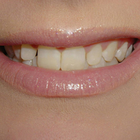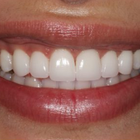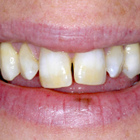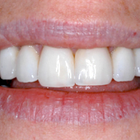Veneers in Dominican Republic
Search and Compare the Best Clinics and Doctors at the Lowest Prices for Veneers in Dominican Republic

Find the best clinics for Veneers in Dominican Republic
With Medijump you can browse 5 facilities offering Veneers procedures in Dominican Republic. The cheapest price available is $200 in Santo Domingo. And for the cheapest price globally, prices start from $1 in Vietnam.
Veneers in Santo Domingo
Price: $ 200
Vietnam offers the best prices Worldwide
Price: $ 1
Dr. Mabel Bonilla, located in Calle Guayubin Olivo, Santo Domingo, Dominican Republic offers patients Veneers procedures among its total of 5 available procedures, across 1 different specialties. The cost of a Veneers procedure ranges from $200 to $300, whilst the national average price is approximately $434. All procedures and treatments are undertaken by just a small team of specialists, with 2 in total at the Dental, and they are accredited by American Dental Association
From 2 verified reviews
Joseph Salazar, 04 June 2019
After weighing in all things that need to be considered and the different options available for dental tourism, and reading a lot of reviews, I decided to go to Santo Domingo, Dominican Republic, to see Dr. Juan Tomas Pena.The Dr. and his team at Denstetica were amazing, knowledgeable, attentive, very welcoming and friendly.The first phase of my treatment involved four implants and the extraction of a molar; after the implants have set, I will go back for phase two, which is to have my crowns done.Dr. Pena, was very thorough during his examination and throughout his work, making sure that I was comfortable and that everything was done to perfection; all in about 4 hours and I didn’t have any swelling!I surely recommend Dr. Pena and his fantastic group at Denstetica!
From 70 verified reviews
Danielle Courteau, 23 November 2019
Highly competent dentists and specialists, efficient staff. Highly recommended.
Hispadent - Jose Alonso MD, located in Calle Guayubin Olivo, Santo Domingo, Dominican Republic offers patients Veneers procedures among its total of 38 available procedures, across 2 different specialties. Currently, there's no pricing information for Veneers procedures at Hispadent - Jose Alonso MD, as all prices are available on request only, whilst the national average price is approximately $434. There are many specialists available at the Dental, with 4 in total, and they have multiple recognized accreditations, including: AAAM - American Academy of Aesthetic MedicineAGD - Academy of General DentistryAACD - American Academy of Cosmetic DentistryAAID - American Academy of Implant DentistryAOD - Asociacion Odontologica Dominicana
From 2 verified reviews
Ronald, 03 March 2018
Excellent clarified all my doubts and the very personalized treatment Thanks to Ms. Denisse.
- Home
- Dominican Republic
Compare Before & After Photos of _procedure_photos.phpVeneers


Front view


Half-side view


Front view


Front view
WHY US?
At Medijump, we're making medical easy. You can search, compare, discuss, and book your medical all in one place. We open the door to the best medical providers worldwide, saving you time and energy along the way, and it's all for FREE, no hidden fees, and no price markups guaranteed. So what are you waiting for?

Free

Best Price

Widest Selection

Risk-Free
What you need to know about Veneers in Dominican Republic

Dental veneers are thin covers that are attached to the surface of teeth to enhance their appearance. The non-invasive dentral procedure is previously popular among those with damaged or discolored teeth. Nowadays, however, the procedure is seen as the ideal method of achieving the ‘perfect smile.'
Veneers can be used to hide uneven, misaligned or simply imperfect teeth. The veneers are cemented over the existing teeth and fixed into place – there are two main types of veneer; Porcelain and Composite. Porcelain veneers are more expensive and appear more natural, being made in a laboratory so require multiple visits. There is often the need to alter the existing teeth, removing some of the mass. Composite veneers are made of the same materials used for cavity fillings. They can usually be made quickly, and are sculpted directly on the teeth instead of in a laboratory. Thus allowing the procedure to be done in a day.
What does a Veneers Procedure Involve?
Veneers are used primarily for aesthetics. This type of treatment procedure is perfect for people who have gaps in their teeth, stains, as well as people who may have chipped a tooth. Veneers are custom-made shells designed to fit the shape of your teeth and to be attached to your front teeth to improve the size, shape, color, and length.
Two main types of veneers are:
- Composite Veneer - this type can be created by your dentist on the same day and directly applied to your teeth. You will only need a single appointment to complete the procedure.
- Porcelain Veneer - this type is manufactured in a laboratory. Opting for a porcelain veneer will require you to have two appointments. First, is to prepare your teeth (enamel removal) and mold a model of your teeth to be created in the lab. The second is to finally cement your veneers onto your teeth.
The most commonly used type of Veneer is the Porcelain Veneer as it appears more natural and can resist stains better than composite veneers. Besides the two main types of veneers, some dentists may also offer no-prep veneers. These may include specific brands of procelain veneers like Vivaneers and Lumineers. They are less invasive to apply since the layers of tooth under the enamel aren't removed.
In terms of anesthetics, local anesthesia is not usually required while undergoing the whole procedure. However, depending on how you handle pain and discomfort, you may request to receive local anesthesia or sedation.
Aside from giving you a pleasing smile, veneers are resistant to staining and offer the best fix to broken or damaged teeth.
How Long Should I Stay in Dominican Republic for a Veneers Procedure?
This type of procedure is an outpatient treatment, meaning you may be able to go home after undergoing the procedure. However, you will be required to do a follow-up check-up with your dentist to assess the placement of your veneers and in most cases, the procedure has to be carried out over 2 separate occasions, just a day or two apart. Since this is a non-invasive treatment, stitches are not required, but you will be required to stay in Dominican Republic for at least a few days.
What's the Recovery Time for Veneers Procedures in Dominican Republic?
There is actually no recovery time after the placement of your veneers. You can also return back to your daily routines including exercise immediately after your trip. As for the enamel removal, you may experience some mild discomfort for about a week. It is best that you avoid very hot or cold foods, including hard, chewy or crunchy food. When your sensitivity wears off, you can return to your normal dietary habits.
What sort of Aftercare is Required for Veneers Procedures in Dominican Republic?
Once your dental veneers have been placed and you have completed the whole procedure, you should commit yourself to good oral hygiene, regular visits to your dentist and a good healthy lifestyle. Dental Veneers can last beyond 10 years now, however, just like your natural teeth, veneers are also still susceptible to damage. This is why aftercare is very important to help with the longevity of your new teeth.
What's the Success Rate of Veneers Procedures in Dominican Republic?
Over the past years, many studies have reported that over 91% of people who have had dental veneers experienced highly positive results. However, potential risks and side effects after undergoing this procedure are a possibility. Just like any other dental restoration, dental veneers can have some side-effects, for example:
- Tooth sensitivity - since this procedure will require the removal of some enamel, your teeth will become slightly sensitive, following the placement of your veneers.
- Response from gum tissues - your gum tissue might take some time to adjust to your newly placed veneers. Expect to have some minor inflammation and/or discomfort in your gums.
- Risk of trauma - once your teeth’s enamel is removed, it will become more sensitive, thus it will be even possible for the pulp within your teeth to die.
- Possible Issues with placement - it's possible for your teeth to have issues with decay or chipping along the outer portion of your veneers. Gum irritation may also be possible. Other problems may include rough-edged veneers and overhanging veneers.
- Overall Discomfort - experiencing some discomfort after the procedure is to be expected. If you are particularly sensitive, it is advisable that you take an over the counter medication to help you relax and treat your pain.
Are there Alternatives to Veneers Procedures in Dominican Republic?
You also have to be aware that this type of treatment option is not for everyone. If you are not a good candidate to undergo the procedure, note that there are still possible alternatives that will be suited for you. These alternatives may include:
Orthodontics - if you have severely crooked teeth or malocclusion, dental veneers are not for you. You may want to consider a more comprehensive orthodontic procedure to treat your case.
Dental crowns - these are quite similar to dental veneers. These are also custom-made to match the shape of your teeth. However, unlike veneers, a crown extends all the way around your tooth, meaning your dentist will remove a large portion of your dental structure. These crowns are perfect for patients who have considerable damage that affects the strength and structure of their teeth.
Bonding - often called composite veneers. This is typically for patients with an insufficient amount of tooth enamel.
Whilst the information presented here has been accurately sourced and verified by a medical professional for its accuracy, it is still advised to consult with your doctor before pursuing a medical treatment at one of the listed medical providers
No Time?
Tell us what you're looking for and we'll reachout to the top clinics all at once
Enquire Now

Popular Procedures in Dominican Republic
Prices Start From $1

Prices Start From $1

Prices Start From $48

Prices Start From $1

Prices Start From $1

Prices Start From $1

Prices Start From $11

Prices Start From $45

Recommended Medical Centers in Dominican Republic for Veneers

- Interpreter services
- Translation service
- Religious facilities
- Medical records transfer
- Medical travel insurance
- Health insurance coordination
- TV in the room
- Safe in the room
- Phone in the room
- Private rooms for patients available

- Interpreter services
- Translation service
- Religious facilities
- Medical records transfer
- Medical travel insurance
- Health insurance coordination
- TV in the room
- Safe in the room
- Phone in the room
- Private rooms for patients available

- Interpreter services
- Translation service
- Religious facilities
- Medical records transfer
- Medical travel insurance
- Health insurance coordination
- TV in the room
- Safe in the room
- Phone in the room
- Private rooms for patients available

- Interpreter services
- Translation service
- Religious facilities
- Medical records transfer
- Medical travel insurance
- Health insurance coordination
- TV in the room
- Safe in the room
- Phone in the room
- Private rooms for patients available

- Interpreter services
- Translation service
- Religious facilities
- Medical records transfer
- Medical travel insurance
- Health insurance coordination
- TV in the room
- Safe in the room
- Phone in the room
- Private rooms for patients available

- Interpreter services
- Translation service
- Religious facilities
- Medical records transfer
- Medical travel insurance
- Health insurance coordination
- TV in the room
- Safe in the room
- Phone in the room
- Private rooms for patients available

- Interpreter services
- Translation service
- Religious facilities
- Medical records transfer
- Medical travel insurance
- Health insurance coordination
- TV in the room
- Safe in the room
- Phone in the room
- Private rooms for patients available

- Interpreter services
- Translation service
- Religious facilities
- Medical records transfer
- Medical travel insurance
- Health insurance coordination
- TV in the room
- Safe in the room
- Phone in the room
- Private rooms for patients available
Veneers in and around Dominican Republic
About the Dominican Republic
The Dominican Republic can be found on the island of Hispaniola and is a part of the island group, the Great Antilles. The nation has diverse natural environments and land features. Characterized by rugged mountains on one side and the other side consist of low lying valleys and coastal plains. It is the world’s leading producer of professional baseball players. It is also home to the highest mountain, Pico Duarte, and the largest lake, Lago Enriquillo in the Caribbean Region.
In recent times, the Dominican Republic has become popular with medical tourists. Tourists, particularly from the United States, visit the country for Plastic and Reconstructive surgeries, especially for Breast Augmentation procedure. About 25,000 to 30,000 patients visit the Dominican Republic yearly for various medical treatments. The most sought-after services are general, Plastic and cosmetic surgeries, dental procedures, weight-loss, oncology, and orthopedic treatments.
Most medical service providers are situated around the capital city Santa Domingo and Santiago. The medical establishments offer competitive healthcare services with highly-qualified and internationally-trained surgeons. The following clinics can be found in Santa Domingo: Dr. Rafael E. Estevez - Plastic, Reconstructive, and Aesthetic Surgeon, Dr. Gustavo Almanzar Plastic Surgery Clinic, Alba Reyes Skin, and Hair Transplant Institute and Dr. Ivan Strachan Bariatric Clinic.
Popular Parts of Dominican Republic
The Dominican Republic is an unmatched destination with amazing natural sceneries, intriguing history, and diverse culture. It offers ecotourism adventures in splendid national parks, mountain ranges, beaches, and rivers.
Top attractions of the Dominican Republic:
- Santa Domingo – The capital city is where Christopher Columbus first set foot in the Americas. It is home to century-old buildings, most of which function as restaurants, shops, quaint hotels, and museums. Zona Colonial is the historic central area of Santa Domingo. It is the oldest European settlement and a UNESCO World Heritage Site.
- Punta Cana –Is a premier resort destination, bordering the Caribbean Sea and the Atlantic Ocean. It offers about 20 miles of white sandy beaches. The Bavaro Beach area and Punta Cana together form the Coconut Coast, an area of luxurious resorts. It is famous for water activities such as zip-lining, kayaking, windsurfing, and sailing.
- Samara Province –Is a city overlooking the Samana Bay. Its unique feature is the breeding point for thousands of humpback whales during their mating season in winter.
- Parque Nacional Del Este – Meaning the ‘Eastern National Park’, is one of the largest marine parks in the Caribbean. It also has an offshore coral reef system. Divers can watch a multitude of marine life within its waters. It is also home to hundreds of different species of birds, tropical forests and beaches.
- Lago Enriquillo – The massive hypersaline lake lies 140 feet below the sea level. You will see a large population of American crocodiles as well as pink flamingos, and various other bird species and you will even find iguanas at the entrance of the lake.
- El Limon Waterfalls – Being the tallest falls of the country, it is perfect for hiking and horseback riding through the rugged and steep mountain trail. The hike gives you a stunning view of the Caribbean landscape. The crystal-clear natural pool at its foot is a perfect place to cool off and relax.
- Kite Beach, Cabarete –Is a unique beach, about 20 minutes on foot from the main Cabarete Beach. Kiteboarders fill the otherwise quiet beach in the afternoons when the wind picks up.
Jarabacoa, Sosua, La Romana, Las Aguilas, and Puerto Plata & Playa Dorada are several other popular tourist spots in the Dominican Republic.
Weather and Climate in the Dominican Republic
The Dominican Republic has a tropical weather climate, and constant temperature throughout the year, with average yearly temperature, is around 77°F.
The hottest and humid period is from May to October. The mild winter season is from December to March. The period between November and April are the moderate seasons.
Rainfall is seasonal. The eastern and southern coasts experience rains between April and October. The northern coast receives rains throughout the year due to the influence of the north-eastern trade winds. The southern region is prone to hurricanes, with most striking in the months of August and September.
Getting Around in the Dominican Republic
The Dominican Republic offers easy access to the rest of the world with a myriad of flight options from North America and Europe. The main ports of entry into the country by air are the international airports in Santa Domingo, Punta Cana, and Puerto Plata. Santiago and Samana airports are other points of entry.
There are many flights from major cities of Canada and the US. The most frequent flights are from New York, Miami, Toronto, and Montreal. JetBlue, the budget airlines, operates flights from North America to Santo Domingo, Santiago, and Puerto Plata.
The Dominican Republic has a well-developed inter-country transport infrastructure with a large network of roads. It has many types of public transportation for moving around within cities such as buses, the metro, carro publicos, guaguas, and the motoconchos.
Carro Publicos are small car-public taxis and have a specific route displayed on their roof. Guaguas are privately-owned minivans and pick up travelers from any point and drop them off close to their desired location. Motoconchos are private motorcycle taxis that have reasonable fares and are ideal for short journeys.
Tourist Visas in the Dominican Republic
Citizens of countries such as the UK, USA, and Canada, and Schengen countries are not required to have a tourist visa to enter the Dominican Republic, under a bilateral agreement between the countries. However, they do need to:
- Carry a tourist card (Tourist cards allow you to stay for 30 days and allow an extension to stay beyond 30 days).
- Have a valid passport not expiring before six months with at least one blank page
- Carry proof of onward and return journeys and sufficient funds.
Nationals of countries like India, Sri Lanka, China, and Russia need to get a tourist visa to travel to the Dominican Republic. The visas are multiple-entry type and are valid for 60 days.
Additional Information
- The Dominican Peso (RD$) is the official currency of the country. As of April 2019, one US Dollar is worth about 51 RD$. Major tourist areas like Punta Cana accept US Dollars.
- You can find many ATMs in Santa Domingo and other popular tourist cities. Dominican Republic banks are members of the Maestro, Citrus, and PLUS networks. Hence, you can use the affiliate credit and debit cards here.
- Spanish is the official and major language of the country. Dominican Spanish forms its dialect. Very few locals understand and speak English.
- 93% of the population follow Roman Catholicism. However, many Dominicans do not go to church on a regular basis.
- Major holidays of the Dominican Republic are religious. While others are non-religious and national holidays. Other than Christmas and Good Friday, the Day of Our Lady of Altagracia (January 21), Corpus Christi (June 17) and the Feast of Our Lady of Mercy (September 24) are the religious holidays. Juan Pablo Duarte (January 26), Independence Day (February 27), and Dominican Restoration Day (August 16) are the national holidays specific to the country.
Popular Searches
- Plastic Surgery in Thailand
- Dental Implants in Thailand
- Hair Transplant in Thailand
- Breast Augmentation Thailand
- Gastric Sleeve in Thailand
- Gender Reassignment Surgery in Thailand
- Laser Hair Removal in Bangkok
- Botox in Bangkok
- Dermatology in Bangkok
- Breast Augmentation in Bangkok
- Coolsculpting in Bangkok
- Veneers in Turkey
- Hair Transplant in Turkey
- Rhinoplasty in Turkey
- Stem Cell Therapy in Mexico
- Rhinoplasty in Mexico
- Liposuction in Mexico
- Coolsculpting in Tijuana
- Rhinoplasty in Korea
- Scar Removal in Korea
- Gastric Sleeve in Turkey
- Bone Marrow Transplant in India
- Invisalign in Malaysia
- Plastic Surgery in the Dominican Republic
- Tummy Tuck in the Dominican Republic
- Plastic and Cosmetic Surgery in Poland
- Rhinoplasty in Poland
- Hair Implant in Poland
- Dental Implants in Poland
- IVF in Turkey




